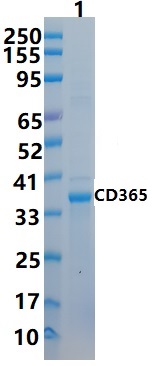Product Name :
CD365 Recombinant Protein Swiss-Prot :
Q96D42 Host :
E.coli Tag :
≥0.5mg/ml Amino acid Sequence :
SVKVGGEAGPSVTLPCHYSGAVTSMCWNRGSCSLFTCQNGIVWTNGTHVTYRKDTRYKLL GDLSRRDVSLTIENTAVSDSGVYCCRVEHRGWFNDMKITVSLEIVPPKVTTTPIVTTVPT VTTVRTSTTVPTTTTVPMTTVPTTTVPTTMSIPTTTTVLTTMTVSTTTSVPTTTSIPTTT SVPVTTTVSTFVPPMPLPRQNHEPVATSPSSPQPAETHPTTLQGAIRREPTSSPLYSYTT DGNDTVTESSDGLWNNNQTQLFLEHSLLTANTTKG Restriction sites :
NdeI-XhoI Background :
T cell Ig- and mucin-domain-containing molecules (TIMs) are a family of transmembrane proteins expressed by various immune cells. TIM-1 (HAVCR1 (hepatitis A virus cellular receptor 1), KIM-1 (kidney injury molecule-1) was originally identified as a receptor for hepatitis A virus. TIM-1 also acts as a costimulatory receptor on T cells and following activation, associates with the TCR complex to upregulate signaling and cytokine production. Another TIM family member, TIM-4, is expressed by antigen presenting cells and is a ligand for TIM-1. TIM-1 expressed by Th1 and Th17 cells was also recently shown to interact with P-selectin to mediate T cell trafficking during inflammation and autoimmune disease. NKT cells also express TIM-1, and engagement of TIM-1 on NKT cells leads to increased production of IL-4, but decreased production of IFN-gamma. TIM-1 is also a receptor for phosphatidylserine exposed by cells undergoing apoptosis. Detection of phosphatidylserine by TIM-1 expressed on NKT cells results in activation, proliferation, and cytokine production. Expression of TIM-1 on regulatory B cells is required for optimal production of IL-10. Mice lacking the TIM-1 mucin domain have decreased production of IL-10 by regulatory B cells, hyperactive T cells, increased levels of inflammatory cytokines, and enhanced severity of autoimmune disease. In addition, TIM-1 polymorphisms are associated with susceptibility to atopic diseases including asthma. Finally, expression of TIM-1 is increased in renal tubular epithelial cells following kidney injury. Soluble :
PBS, 4M Urea, PH7.4 Purification&Purity :
Transferred into competent cells and the supernatant was purified by NI column affinity chromatography and the purity is > 85% (by SDS-PAGE). Storage&Stability :
Store at 4°C short term. Aliquot and store at -20°C long term. Avoid freeze-thaw cycles. Expression vector :
pet-22b(+) BiowMW :
~34kDa Note :
For research use only, not for use in diagnostic procedure. concentration :
≥0.5mg/ml
CD365 Recombinant Protein Swiss-Prot :
Q96D42 Host :
E.coli Tag :
≥0.5mg/ml Amino acid Sequence :
SVKVGGEAGPSVTLPCHYSGAVTSMCWNRGSCSLFTCQNGIVWTNGTHVTYRKDTRYKLL GDLSRRDVSLTIENTAVSDSGVYCCRVEHRGWFNDMKITVSLEIVPPKVTTTPIVTTVPT VTTVRTSTTVPTTTTVPMTTVPTTTVPTTMSIPTTTTVLTTMTVSTTTSVPTTTSIPTTT SVPVTTTVSTFVPPMPLPRQNHEPVATSPSSPQPAETHPTTLQGAIRREPTSSPLYSYTT DGNDTVTESSDGLWNNNQTQLFLEHSLLTANTTKG Restriction sites :
NdeI-XhoI Background :
T cell Ig- and mucin-domain-containing molecules (TIMs) are a family of transmembrane proteins expressed by various immune cells. TIM-1 (HAVCR1 (hepatitis A virus cellular receptor 1), KIM-1 (kidney injury molecule-1) was originally identified as a receptor for hepatitis A virus. TIM-1 also acts as a costimulatory receptor on T cells and following activation, associates with the TCR complex to upregulate signaling and cytokine production. Another TIM family member, TIM-4, is expressed by antigen presenting cells and is a ligand for TIM-1. TIM-1 expressed by Th1 and Th17 cells was also recently shown to interact with P-selectin to mediate T cell trafficking during inflammation and autoimmune disease. NKT cells also express TIM-1, and engagement of TIM-1 on NKT cells leads to increased production of IL-4, but decreased production of IFN-gamma. TIM-1 is also a receptor for phosphatidylserine exposed by cells undergoing apoptosis. Detection of phosphatidylserine by TIM-1 expressed on NKT cells results in activation, proliferation, and cytokine production. Expression of TIM-1 on regulatory B cells is required for optimal production of IL-10. Mice lacking the TIM-1 mucin domain have decreased production of IL-10 by regulatory B cells, hyperactive T cells, increased levels of inflammatory cytokines, and enhanced severity of autoimmune disease. In addition, TIM-1 polymorphisms are associated with susceptibility to atopic diseases including asthma. Finally, expression of TIM-1 is increased in renal tubular epithelial cells following kidney injury. Soluble :
PBS, 4M Urea, PH7.4 Purification&Purity :
Transferred into competent cells and the supernatant was purified by NI column affinity chromatography and the purity is > 85% (by SDS-PAGE). Storage&Stability :
Store at 4°C short term. Aliquot and store at -20°C long term. Avoid freeze-thaw cycles. Expression vector :
pet-22b(+) BiowMW :
~34kDa Note :
For research use only, not for use in diagnostic procedure. concentration :
≥0.5mg/ml
Blocking peptide available as NCP0329P

 CD365 Recombinant Protein
CD365 Recombinant Protein 
 Datasheet
Datasheet COA
COA MSDS
MSDS SHIP
SHIP